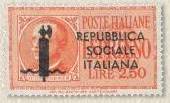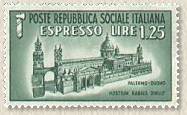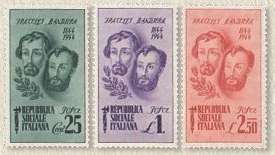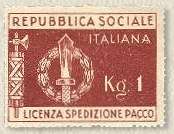
The period from September 23, 1943, to April 25, 1945, corresponding to that of the Republican Government, is represented by the use of the "imperial" set values overprinted "G.N.R." (Republican National Guard) with a local and provisional characteristic; use of the "imperial" set values, overprinted "Italian Social Republic", with a "fascio littorio" (fasces of the Roman lictors), or with writing superimposed on fasces; and commemorative issues.

Issues of the "Republican National Guard" with the typographic overprint "G.N.R." in red or black were released between December 20, 1943 and February 1944. They were overprinted on the "imperial" set stamps of 1929-42 (20 values); on Kingdom airmail stamps (2 values); on Kingdom express stamps (2 values); on war propaganda stamps of the Kingdom (12 values); and on Kingdom postage-due stamps (13 values). The first issue was produced by Bontacchino Typography in Brescia, the following by the Chiamenti Typography in Verona.

Issues of the "Italian Social Republic" from January 22, 1944, had different overprint types in red or black on the "imperial" set stamps with the effigy of Victor Emmanuel III (5 values), on Kingdom express stamps (2 values), on Kingdom war propaganda stamps (12 values), on Kingdom parcel post stamps (12 values), on Kingdom authorized delivery stamp (1 value), and on Kingdom postage-due stamps (12 values). Overprint types were: a) fasces superimposed on the three-line legend "Italian Social Republic"; b) "fascio littorio"; c) "Italian Social Republic" in three lines; d) "fascio littorio" on the left and the three-line legend "Italian Social Republic" on the right, or reversed.
The 50 Lira stamp of the "imperial" set was overprinted in Florence with a "fascio littorio" in carmine violet (February 1944) and in red on the following Verona issue (April 1944).
After March 16, 1944, all Kingdom stamps with the King's effigy were declared invalid.




On June 5, 1944, an ordinary four-value set named "Destroyed Monuments" or "Tamburino" (drummer) was issued. These were printed by rotogravure by the State Printing Institute (I.P.S.) in Rome for the 20c and 25c values, and by the Novara section of I.P.S. for the 30c and 75c values. The first two values depict the Merchant's Arcade in Bologna and the Basilica of St. Lorenzo in Rome; both monumental palaces had suffered heavy damage from Anglo-American bombing during the summer of 1943. The two remaining values depict a drummer marching in time and screaming "All'armi, all'armi!", which is the first and most significant verse of a famous fascist song.




Between August 1944 and March 1945, a second set "Destroyed Monuments" was issued consisting of 10 values plus one express stamp, printed in rotogravure by the Novara section of I.P.S. This shows the transfer of the printing activity to the north, following the retreat of Mussolini's republican government. Along with the above mentioned designs in the first issue, the following are depicted: 5c, S. Ciriaco Church in Ancona; 10c and 1 Lira, Montecassino Abbey; 1.25 and 3 Lira, St. Maria delle Grazie Church in Milan; 50c, allegory of republican and fascist Italy. These monuments had been damaged by the Anglo-American aerial bombing.

The 1.25 Lira express, which is part of the same issue, depicts the Palermo Dome. Unlike the previous monuments, the monument of Palermo didn't suffer from any war damage.

On December 6, 1944, a three-value set was issued which commemorated the "centenary of the death of the Bandiera brothers", printed in rotogravure by the Novara section of I.P.S. There's a single design which depicts the faces of Attilio and Emilio Bandiera.
The last three sets were the only commemoratives that were issued during the period September 1943 - April 1945.

Finally, in 1945, a military stamp was issued to be used for the mailing of packages not exceeding 1 kg in weight addressed to soldiers (military postage free).
Following the fall of the Social Italian Republic (April 25, 1945), the issues mentioned above were no longer valid. In spite of this, the stamps available in Northern Italy continued to be used at face value, totally or partially in the various zones, because of delays in receiving supplies of new stamps from Rome. This situation stabilized between the end of 1945 and the beginning of 1946.
 |
 |
|
 |
 |